Harbin remembers its Jewish past 哈尔滨犹太人历史记忆
In China, only Shanghai was home to more Jews than Harbin. 在中国,定居于哈尔滨的犹太人仅少于上海。
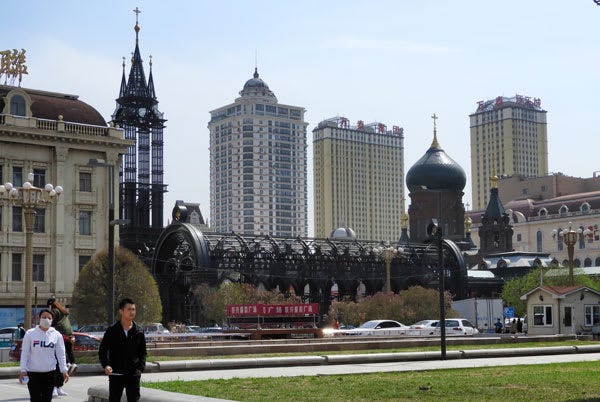
Harbin, the capital of Heilongjiang Province, is best known for its annual Ice Festival. However it was once known as the “Moscow of the East.”
哈尔滨市,黑龙江省省会,以每年一度的冰雪节而闻名。然而,它曾被称为“东方莫斯科”。
Harbin’s development began with the start of the Russian invasion of Manchuria towards the end the 19th century. 哈尔滨的发展始于19世纪末。

The famous Russian-style Harbin sausage 著名的俄国风味-哈尔滨红肠
The construction of the Chinese Eastern Railroad began in August 1897 and opened for traffic in November 1903. In the same year, several Russian Jewish families moved to Harbin.
中国东部铁路始建于1897年8月,1903年11月通车。同年,几个俄罗斯犹太家庭落户于哈尔滨。
By 1903 about 500 Jews existed in Harbin. After the Russo-Japanese war of 1905, many demobilized Jewish soldiers settled in Harbin. They were followed by refugees from the 1905-07 pogroms in southern-western Russian regions. By 1908, there were about 8,000 Jews in the city.
至1903年,哈尔滨大约有500名犹太人。1905年日俄战争后,许多被遣散的犹太士兵定居在哈尔滨。紧随其后的是1905年至1907年在俄罗斯西南部地区发生的大屠杀中的难民。到1908年,该市大约有8000名犹太人。
After World War I 第一次世界大战后
The Jewish community was sharply increased by the influx of Jewish refugees during World War I, the Russian revolution (1917), and Russian Civil war. It reached its peak, 15,000 – 20,000, in the early 1930’s.
在第一次世界大战期间,俄国革命(l917)和俄罗斯内战期间,犹太社区难民的涌入大幅度地增加,在1930年代初达到了顶峰,从15000增至20000名。

Even though the last Jewish family left Harbin in 1963 and Judaism isn’t a recognized religion in China, two historic synagogues have survived.
尽管最后一个犹太家庭在1963年才离开哈尔滨,犹太教在中国也不是一个被公认的宗教,但有两个历史悠久的犹太教堂却幸存下来。
The photo above is the New Synagogue. Today it is a Jewish museum.
以上照片是新会堂。今天,它成为一座犹太博物馆。
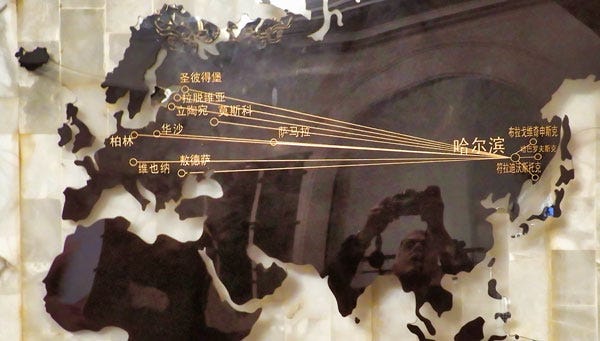
The museum tells the story of Harbin’s Jewish community. Starting in the late 19th century until World War II, thousands of European and Russian Jews fled to Harbin to escape persecution.
博物馆讲述了哈尔滨犹太社区的故事。从19世纪末到第二次世界大战期间,成千上万的欧洲和俄罗斯犹太人逃到哈尔滨躲避迫害。

Instead of being scorned, the Jews were welcome in Harbin.
犹太人没有被嘲笑,反而在哈尔滨受到欢迎。

This is inside the museum. 这是博物馆内部。
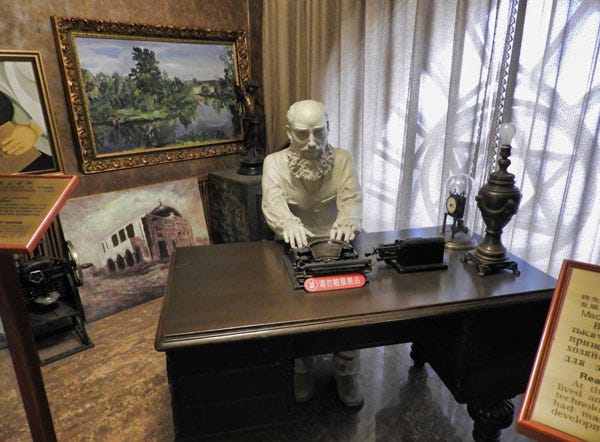
Here is a Jewish industrialist’s office. 这是一位犹太实业家的办公室。


The museum gives an idea of the culture and the home life that Jews enjoyed in Harbin. 该博物馆展示了犹太人在哈尔滨享有的文化和家庭生活。


Music was so important in their lives. Notice the candlestick holders on the piano.
音乐在他们的生活中如此重要。注意钢琴上的烛台架。
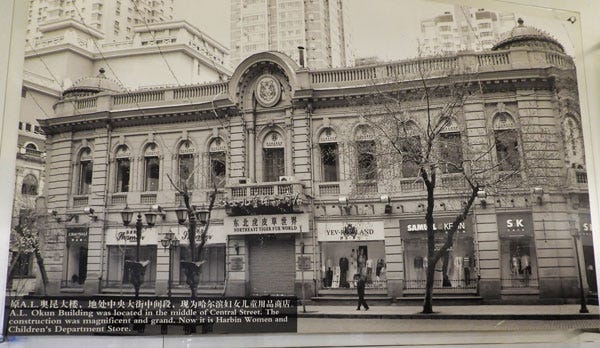
This building is located on Central Street. It was originally owned by a Jewish business. 这座大楼位于中央大街。它最初属于一家犹太企业。

Central Street in today’s China. Many of the old Russian and Jewish buildings are still in use along this famous pedestrian mall. The roadway features the original Russian cobblestones.
今天中国的中央大街。沿这条著名的步行街望去,许多古老的俄罗斯和犹太建筑仍在使用。这条道路的特色是原有的俄罗斯鹅卵石。
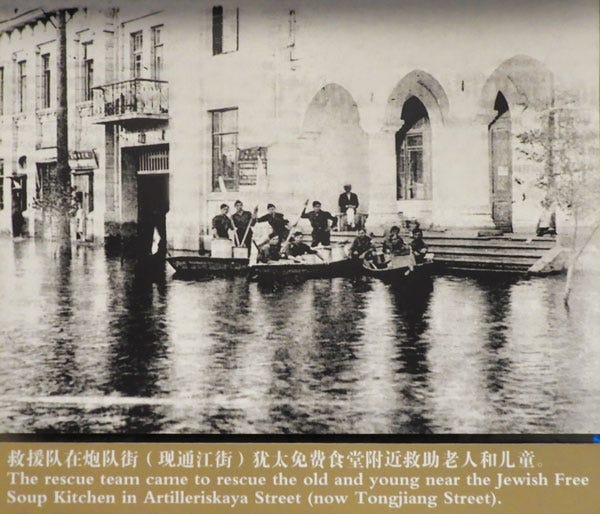
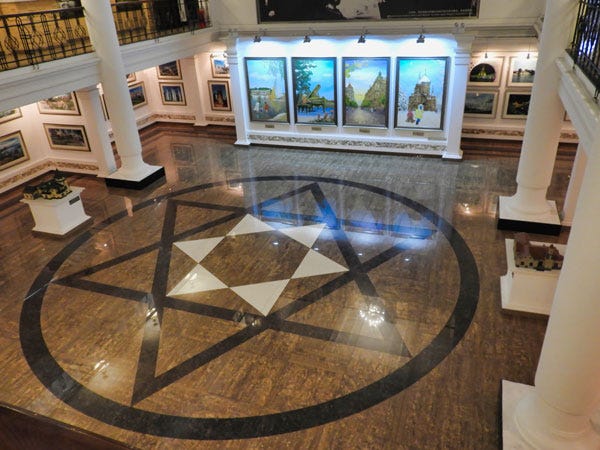
The museum features hundreds of photographs and documents showing Jewish life in Harbin. 该博物馆展出了数百幅展示哈尔滨犹太人生活的照片和文件。

There is a book, “The Jews in Harbin” that contains many of the photographs and documents that are kept in this museum. You can find it on the Amazon website.
有一本书叫《哈尔滨的犹太人》,里面有很多保存在这个博物馆里的照片和文件。可以在亚马逊网站上找到。

This is the street outside the museum. As I walked north on this street towards the old synagogue, 这是博物馆外面的街道。我沿这条街道向北走向老犹太教堂。
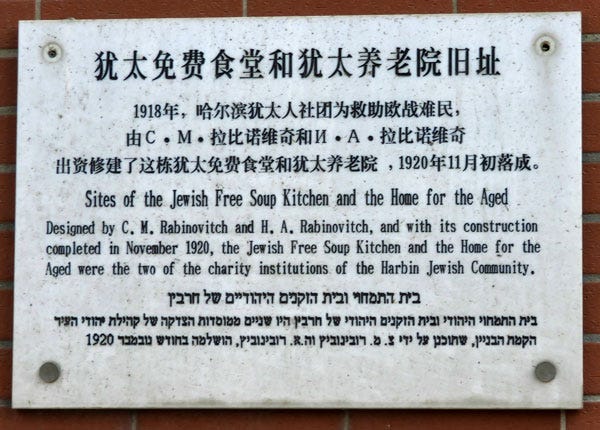
I saw this plague on the wall of one of the buildings.
从一所建筑的墙上可看到它所经历的磨难。

This is the top of the Old Synagogue. 这是老犹太教堂的顶部。

The building is now used as a concert hall. There are concerts most evenings.
现该建筑用来作音乐厅。晚上的大部分时间在这里举行音乐会。

This building was a Jewish school. (See the design in the window frame.)
该建筑是一所犹太学校。(见窗框设计)。

It is now used as a music school. I walked in and an employee, who spoke no English, gave me a brief tour and then I was free to look around.
现在这里是一所音乐学校。我走了进来,一位员工,不会说英语,他做了一下简单介绍,允许我进来随便到处看看。
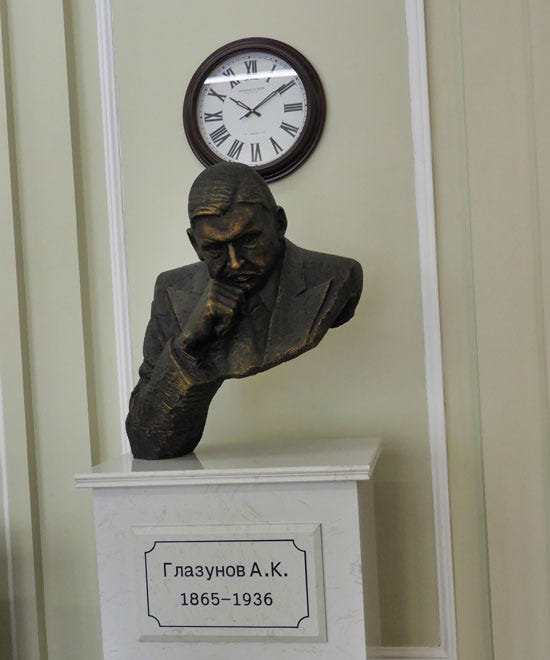
A statue honouring a Russian—I think. 一座纪念俄罗斯人的雕像—我想。

A window in a room used to teach dancing.
从一个窗口向房间里看去,现在这里用于舞蹈教学。

Again, the windows show the building’s history.
再次看到,窗户展示出其建筑历史。

This is a group of seniors who are taking singing lessons. They belong to a chorus.
有一群中老年人在上声乐课。他们所属一个合唱团。
When they saw me peeking into the room, they invited me in to sit with them. I stayed longer than I thought I would. (It would have been impolite to leave in the middle of their lesson.)
当他们发现我向教室里面窥视,便热情邀请我进入教室与他们同坐聆听。我没料到在那会待了那么长时间(授课期间中途离开是不礼貌的)。
The teacher was very tough with her students. I was very impressed with her. She had the students practice over and over until she was satisfied.
给我留下非常深刻印象的是,老师对她的学生要求非常严格,学生们一遍又一遍地习唱,直到她满意为止。


